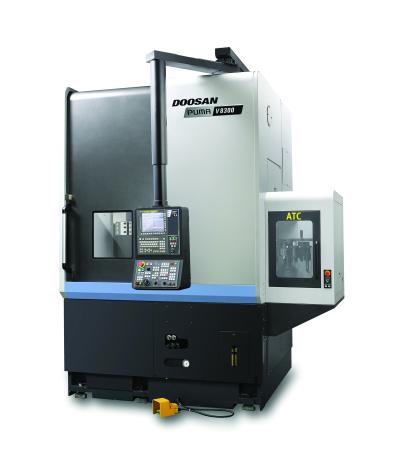
Doosan Machine Tools presents the new PUMA V8300 vertical turning center with an automatic toolchanger (ATC). The PUMA V8300 is a new generation 15-inch class vertical turning center with a large work zone and enhanced rigidity and user convenience. It is available in right- or left-hand versions.
The PUMA V8300 offers a maximum turning diameter of 830mm (32.7“), a maximum work height of 750mm (30”) and a swing-over-saddle of 740mm (29“).
The adoption of a standard 37kW (50hp) high-power spindle motor and a column integral-type box guide structure ensures heavy-duty, stable, dependable turning performance. The high-reliability, servo-driven turret maintains high accuracy during long-term machining. The PUMA V8300 has a maximum spindle speed of 2,000 rpm and maximum torque of 2,592 Nm (1,912 ft-lbs).
The PUMA V8300 comes with an optional 12-station ATC magazine, a feature not usually found on turning centers in this class, according to the company. The ATC supports Capto C6 tooling and is available for all 12 stations of the turret. The tools remain safely out of the way when not in use, providing superior tool management and much easier maintenance.
The PUMA V8300 series is designed with a slanted bed and an improved flushing function for unhindered chip disposal, and expanded coolant system features a 290 liter (77 gallon) tank. It also has an ergonomically designed operation panel that swivels and is height-adjustable and movable for enhanced user convenience.
“We set out to design a new vertical turning center with the features and benefits our aerospace, automotive and energy customers were asking for,” states Jim Shiner, director of sales and marketing at Doosan Machine Tools America. “These characteristics make the PUMA V8300 particularly well-suited for any operation with the need to cut tough materials swiftly and efficiently.”
Contact Details
Related Glossary Terms
- automatic toolchanger
automatic toolchanger
Mechanism typically included in a machining center that, on the appropriate command, removes one cutting tool from the spindle nose and replaces it with another. The changer restores the used tool to the magazine and selects and withdraws the next desired tool from the storage magazine. The changer is controlled by a set of prerecorded/predetermined instructions associated with the part(s) to be produced.
- centers
centers
Cone-shaped pins that support a workpiece by one or two ends during machining. The centers fit into holes drilled in the workpiece ends. Centers that turn with the workpiece are called “live” centers; those that do not are called “dead” centers.
- coolant
coolant
Fluid that reduces temperature buildup at the tool/workpiece interface during machining. Normally takes the form of a liquid such as soluble or chemical mixtures (semisynthetic, synthetic) but can be pressurized air or other gas. Because of water’s ability to absorb great quantities of heat, it is widely used as a coolant and vehicle for various cutting compounds, with the water-to-compound ratio varying with the machining task. See cutting fluid; semisynthetic cutting fluid; soluble-oil cutting fluid; synthetic cutting fluid.
- toolchanger
toolchanger
Carriage or drum attached to a machining center that holds tools until needed; when a tool is needed, the toolchanger inserts the tool into the machine spindle. See automatic toolchanger.
- turning
turning
Workpiece is held in a chuck, mounted on a face plate or secured between centers and rotated while a cutting tool, normally a single-point tool, is fed into it along its periphery or across its end or face. Takes the form of straight turning (cutting along the periphery of the workpiece); taper turning (creating a taper); step turning (turning different-size diameters on the same work); chamfering (beveling an edge or shoulder); facing (cutting on an end); turning threads (usually external but can be internal); roughing (high-volume metal removal); and finishing (final light cuts). Performed on lathes, turning centers, chucking machines, automatic screw machines and similar machines.
